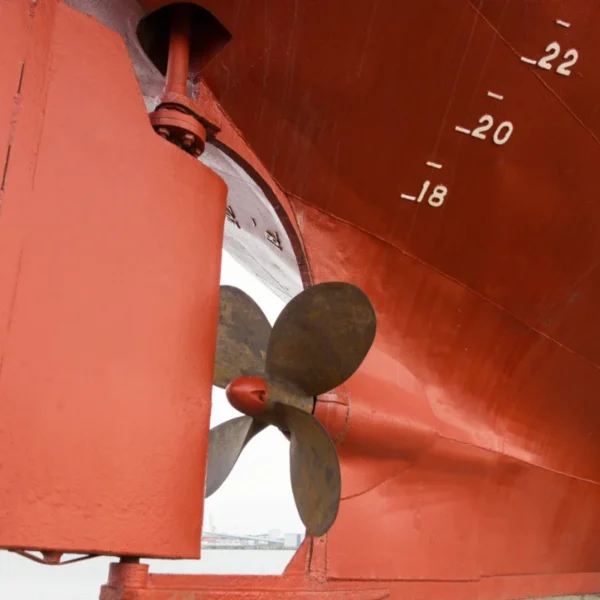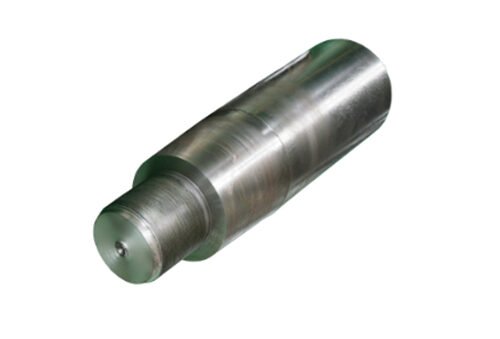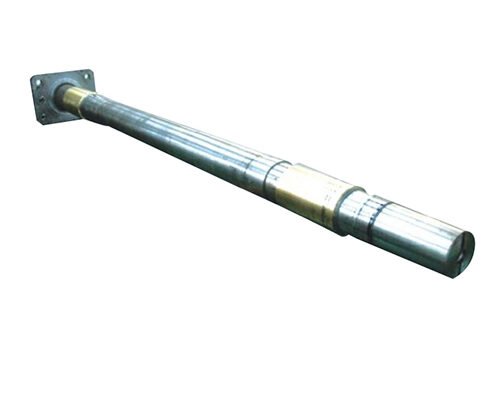A rudder bearing is a general term for any of the crucial support bearings that allow a vessel’s rudder to function. These bearings are responsible for carrying the immense weight of the rudder and absorbing the significant lateral forces and torque generated by the flow of water. Without them, the rudder would not be able to turn smoothly or reliably.
There are two primary types of rudder bearings on a ship: the Rudder Carrier Bearing and the Pintle Bearing.
1. Rudder Carrier Bearing (Rudder Stock Bearing)
- Location: This is the uppermost bearing in the rudder system, located at the top of the rudder stock where it passes through a deck or bulkhead in the steering gear room.
- Function: Its main purpose is to support the entire vertical weight of the rudder assembly. It acts as a thrust bearing, allowing the rudder stock to rotate freely while taking the full downward load. It also helps to absorb some of the lateral forces.
- Materials: Rudder carrier bearings are typically plain bearings made of bronze, white metal (Babbitt metal), or modern composite polymers that offer high load-carrying capacity and low friction. They are usually grease-lubricated.
- Maintenance: The primary maintenance concern is ensuring sufficient lubrication and checking for wear by measuring the vertical “rudder drop” or lift.
2. Pintle Bearing
- Location: This is the lowermost bearing, located at the bottom of the rudder blade. The pintle (a pin on the rudder) fits into the pintle bearing, which is housed in a fitting called the gudgeon on the vessel’s stern frame.
- Function: It serves as the lower pivot point for the rudder and is responsible for absorbing most of the lateral forces from the water flowing against the rudder blade. It also supports a portion of the rudder’s weight.
- Materials: Due to its submerged location and exposure to seawater, the pintle bearing is often made from durable, corrosion-resistant, and self-lubricating materials. These include bronze, lignum vitae (a dense hardwood), or modern composite polymer bearings that are designed to handle abrasive particles and seawater lubrication.
- Maintenance: The main concern is wear due to friction and the ingress of sand or silt. The clearance between the pintle and the bearing must be regularly measured during dry-docking.
Common Spare Parts
A vessel’s spare parts inventory for the rudder system must account for both types of bearings and their associated components.
- Rudder Carrier Bearing:
- Bearing inserts or liners made of the specified material.
- Gaskets and seals for the bearing housing.
- Grease for lubrication.
- Pintle Bearing:
- Bearing inserts or a complete bearing bushing made of the specified material (e.g., polymer, bronze).
- Seals and other components for the pintle.
- Mounting hardware, such as bolts and pins.
- General Spares:
- Anodes for galvanic corrosion protection.
- Specialized tools for measuring wear and clearance.
Key Manufacturers
The market for rudder bearings is led by companies specializing in stern gear and bearing technology.
- Thordon Bearings: A global leader in water-lubricated, non-metallic composite bearings for both rudder stocks and pintles.
- Wärtsilä: Supplies integrated rudder and steering systems, including bearings and seals.
- SKF Marine: A major supplier of rudder stock bearing systems and other marine components.
- Michell Bearings: A manufacturer of high-quality white metal and bronze-lined bearings.
Properly maintained rudder bearings are fundamental to a vessel’s safety and reliability, ensuring that the ship can be steered effectively in all operating conditions.
We offer an extensive range of marine engine brands and their associated spare parts, providing comprehensive solutions for both main propulsion and auxiliary power needs across diverse vessel types. Our supply capability covers various generations and models, ensuring support for a wide array of marine applications.
Featured Brands and Engine Series/Models:
SULZER:
- Two-Stroke Engines:
- RD/RND Series: RD68, RND76, RND76M, RND90, RND90M (Classic large-bore, low-speed engines, still in operation).
- RLA/RLB Series: RLA(B)56, RLA(B)66, RLA(B)76, RLB90 (Developed two-stroke designs).
- RTA/RT-Flex Series: RTA38, RTA48(T), RTA52, RTA58, RTA62, RTA72, RTA76, RTA84, RTA84M, RTA84C, RTA96 (Modern, fuel-efficient, electronically controlled two-stroke engines).
- Four-Stroke Engines:
- Z Series: ZL40/48, 16ZAV40S (Medium-speed engines).
- RF Series: RF44, RF56 (Often used for auxiliary power or generator sets).
- TAD Series: TAD36, TAD48 (For specific applications).
MAN (including pre and post-MAN B&W models):
- Two-Stroke Engines (KZ, KSZ, K, L, S, MC/MC-C, ME/ME-C): 40/54A, 52/90N, 57/80C, KZ57/80F, KSZ70/125, KSZ78/155, 90/160A, 52/55L, 58/64, 90/190C, L60/105E, 70/120E, 70/125C, L, KSZ78/155A, KSZ70/125B, L52/55A, 40/45 (A broad spectrum covering main propulsion and auxiliary engines).
B&W (Burmeister & Wain – prior to MAN B&W merger):
- MC/MCE Series: L35MC, L60MC, L80MC, L55GFCA, L80GFCA, L80GB, 74VT2BF, K62EF, K74EF, K84EF, K45GFC, K67GFK, K80GFK, K90GFS, 45HU, L70MC (Various generations of two-stroke diesel engines).
- MC-C/ME-C Series: L50MC, S60MC, S70MC, K80MC, S80MC, K90MC-C, L67GFCA, L90GB (Electronically controlled and conventional two-stroke engines).
- VT2BF/EF Series: 50VT2BF, 62VT2BF, K84EF (Older models still in service).
MITSUBISHI:
- UEC/UET Series: UEC37L/LA/LS, UEC45HA, UEC60L/LA/LS, UEC45L/LA/LS, UET45/75C, UEC52/125H, UEC52L/LA/LS, UET45/80D, UEC52/90D, UEC(T)52/105D, UEC45/115H, UEC37/88H, UEC37H (Mitsubishi’s proprietary two-stroke and some four-stroke engine series).
PIELSTICK:
- PA Series: PA6, PC3, PC2-2, IHI PC2-5, PC4, PC2-6, PC4-2L, PC4-570, PA5 (High-speed, compact four-stroke engines, commonly used for generator sets or auxiliary propulsion).
AKASAKA:
- UET/UEC/DM/AH Series: UET45/80D, UEC52/105D, DM51SS, UEC 60/150H, UEC 60H, A31, A34, A37, A41, AH27, AH28, AH30, AH36, AH38, AH40, DM30, DM36, DM38, DM46, DM47 (A prevalent engine brand, particularly in Japanese-built vessels).
DEUTZ:
- RBV/TBD/BVM Series: RBV8M358, RBV8M540, RBV16M640, TBD620L6, BVM350, BVM540, BF6M716 (Various four-stroke medium- and high-speed diesel engines for auxiliary and smaller main propulsion applications).
HANSHIN:
- EL/LH/LU/LUN/LUD/LUS Series: EL30, EL32, EL35, EL40, EL44, LH28RG, LH31G, LU28(A,R,G), LU32, LU35, LU38, LU46(A), LU50, LU54, LUN28, LUN30, LUD32, LUD35, LUS38 (Another significant engine brand commonly found in Japanese vessels).
NIIGATA:
- MG/M Series: MG40X(EX), M34X, 6M28BF, TM31X (Medium-speed diesel engines, typically used in small and medium-sized vessels).
MAK:
- M/MU/AK/AKM Series: M332, M453AK, MU551AK, MU552AK, M601, MU452AK, 451AK, 6M453AK, 9M453C, 6M601C, 8M601 (Medium-speed four-stroke engines, widely used in various marine applications).
WARTSILA:
- 20/22/26/32/38/46/GD/TKR Series: 22, 32, 31, 26, 20S, 28, 38, 46, 32GD, 46GD, 14, TKR22, HFR-V32, NOHAB (Wärtsilä’s broad portfolio of medium- and high-speed diesel engines for main propulsion, auxiliary, and generator sets).
DAIHATSU:
- PS/PKT/DS/DL/DK/PL Series: PS-18, PS-22, PS-20, PS-26, PS-30, PKT-14, PKT-16, PKTD-16, DS-18, DS-22, DS-26, DS-28, DS-32, DL-14, DL-16, DL-19, DL-20, DL-22, DL-24, DL-26, DK-20, PL-24 (Compact and reliable engines primarily used for auxiliary power and generator sets).
CUMMINS:
- BT/CT/NT/KTA/QSK/QSM Series: 4BT3.9, 6BT(A)5.9, 6CT8.3, NT(A)855, N14, KTA19, KTA38, KTA50, QSK19, QSM11 (Robust and durable engines for marine auxiliary power, generator sets, and some smaller main propulsion applications).
CATERPILLAR:
- 3000/3100/3300/3400/3500/3600 Series & C Series: 3054, 3056, 3066, 3106, 3126, 3306, 3406, 3408, 3412, 3508, 3512, 3516, 3606, 3608, 3612, 3616, 3618, C1.5, C2.2, C7, C9, C10, C12, C15, C16, C18, C30, C32 (Reliable and widely used engines across a vast range of main propulsion, auxiliary, and generator set applications).
SCANIA:
- DI Series: DI 09, DI 13, DI 16 (High-performance diesel engines designed for marine applications, typically used as auxiliary and smaller main propulsion engines).




